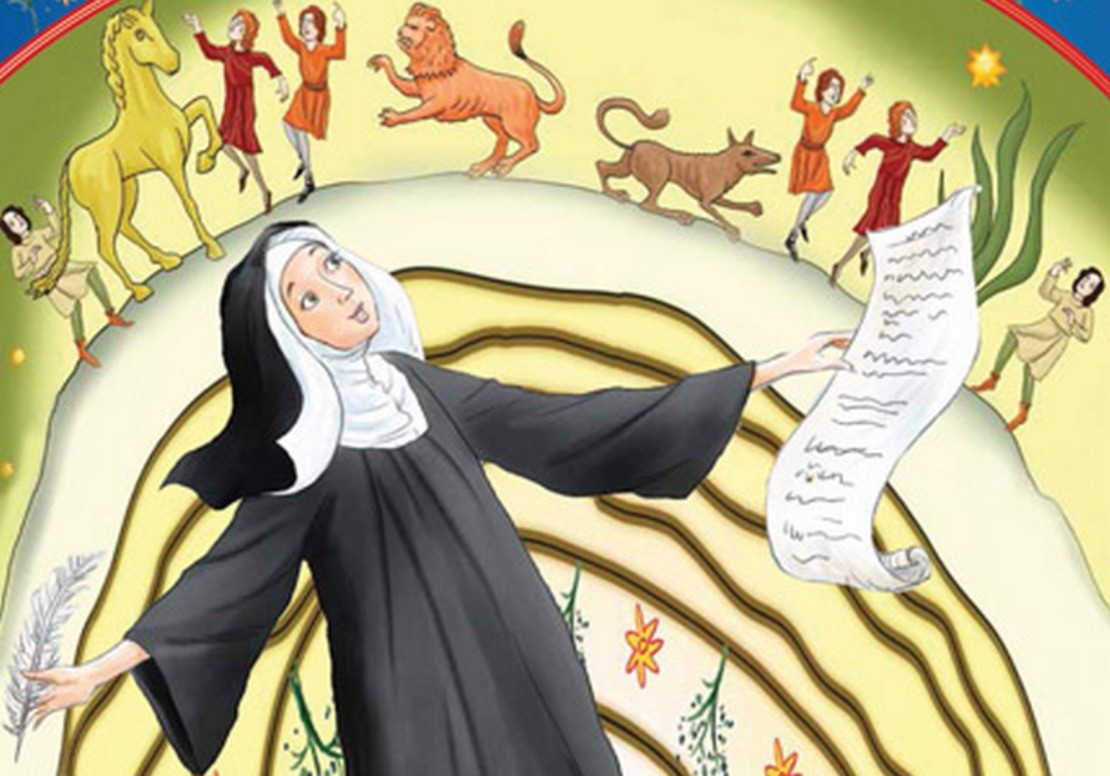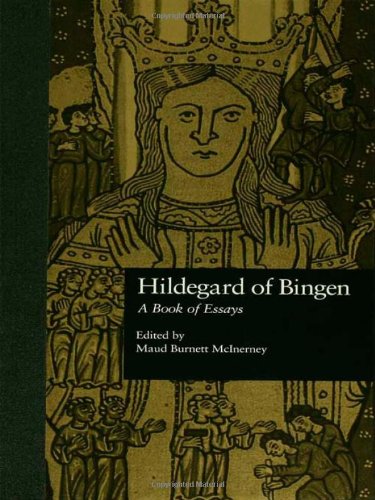
St. Hildegard of Bingen
St. Hildegard of Bingen, whose feast day we celebrate with vigor every September 17, was not only a brilliant composer, artist, and visionary, she was also an herbalist. Her belief in the “greening of man,” or viriditas as she called it, led her to trust that God had given mankind herbs, spices, and foods to serve our bodies and keep us not only healthy but full of joy and peace. What a lovely idea from a truly remarkable woman, living in an age where women were seen primarily as accessories created to adorn men, creatures to woo, or saintly idols to be placed on a pedestal and thought of while on crusade.
Some of her ideas were a bit unorthodox but many are still worthy of consideration–well, some are, anyway. I’m not so sure about this one: “Earthworms have good viriditas and should be smoked over a hot fire until they die, mixed with wheat flour, oak wood, vinegar, and wine. These are not to be eaten, but rather placed on the stomach of one who has scrofula (swollen glands)” (Von Bingen, 1155).
On the lighter side, she offered this recipe for men dealing with carnal lust: “Take dill and a double amount of stream mint, a little more cowslip than stream mint, twice as much from the root of the Illyrium sword lily as stream mint, and as much shallot. … Cut up these ingredients and put them in vinegar, make a seasoning out of it, and then use it on every possible dish” (Von Bingen, n.d.).
According to Hildegard, milk is good with nettle to ward off bad humors, but nettle cannot be eaten in the summertime. The head of a catfish should never be eaten—it lacks viriditas and will cause headaches and fevers. “The wood and leaves of the nutmeg tree are harmful, but nutmeg itself gives a person a positive disposition and calms bitterness of the heart and mind” (Von Bingen, 1155).
Turnips, radishes, and mustard leaves have bad viriditas, but mustard seeds are okay (Von Bingen, 1155). Spelt was the glory food. Hildegard highly recommended it because “it rectifies the flesh, produces proper blood, and creates a happy mind and a joyful human disposition.” She sometimes made little cakes from broad bean flour, powdered fennel seed, water, and wheat flour. Happy days full of joy resulted, I am sure!
For digestive problems, Hildegard said we should “take ginger, grind it up, mix it with a little juice from the plant that is called marigold, and then take some flour and make small cakes out of this powder. Bake these cakes in the oven when the heart of the fire has already begun to be tamped down, and consume these small cakes both before and after breakfast” (McInerney, 1998).
 One of the most interesting “cures” Hildegard left us was her eye salve. She differentiated between treatments for blue-eyed folks as opposed to brown-eyed. Blue eyes were thought to come from the air whereas brown eyes were sturdier and healthier since they came from the earth. Her recipe for eye discomfort for blue eyes: “If someone has blue eyes, with which she somehow sees poorly and feels pain, she should take fennel or fennel seeds when the pain is fresh, pulverize them, press the juice from them, and take the dew which is found on the grass blades standing upright, add a little fine wheat flour, and knead this into a little cake. This she should place over her eyes for the night, tie it in place, and she will feel better. The mild warmth of the fennel, tempered by the dew and strength of the flour, removes these pains. Grey eyes are the airy kind, and therefore dew is added to this mild medicine” (Von Bingen, n.d.).
One of the most interesting “cures” Hildegard left us was her eye salve. She differentiated between treatments for blue-eyed folks as opposed to brown-eyed. Blue eyes were thought to come from the air whereas brown eyes were sturdier and healthier since they came from the earth. Her recipe for eye discomfort for blue eyes: “If someone has blue eyes, with which she somehow sees poorly and feels pain, she should take fennel or fennel seeds when the pain is fresh, pulverize them, press the juice from them, and take the dew which is found on the grass blades standing upright, add a little fine wheat flour, and knead this into a little cake. This she should place over her eyes for the night, tie it in place, and she will feel better. The mild warmth of the fennel, tempered by the dew and strength of the flour, removes these pains. Grey eyes are the airy kind, and therefore dew is added to this mild medicine” (Von Bingen, n.d.).
Here is the cure for brown eye discomfort: “Take rue juice, and twice as much pure liquid honey, and add a little pure good wine. Lay a piece of wheat bread in this mixture, and then tie it on the eyes with the bread overnight” (Von Bingen, n.d.).
When I do my talks with children at book signings, I often bring herbs with me so they can smell or taste them. We talk about the herbs Hildegard used to treat diseases, and they try to grind spelt into flour with a mortar and pestle. It’s such fun to watch their eyes light up as they pound away at the kernels, waiting for them to break open, spelt often flying across the floor. I imagine Hildegard in her dim cell, praying and working in pure Benedictine fashion – ora et labora. What could be more rewarding?
Megan Hoyt is the author of Hildegard’s Gift, a vibrant, colorful picture book for children of all ages, available now through Paraclete Press. For more about Hildegard, check out www.meganhoyt.net.
REFERENCES
Goode-Allen, Jeannine. (2013). Good Eyes. Retrieved from http://viriditasllc.com/blog/
McInerney, Maude Burnett. (Ed.) (1998). Hildegard of Bingen: A Book of Essays. Garland Medieval Casebooks.
Von Bingen, Hildegard. (1155) Physica (Priscilla Throop, Trans. 1998). Rochester, VT: Healing Arts Press
Von Bingen, Hildegard. (n.d.) Causes and Cures (Priscilla Throop, Trans.) LuLu Press.







